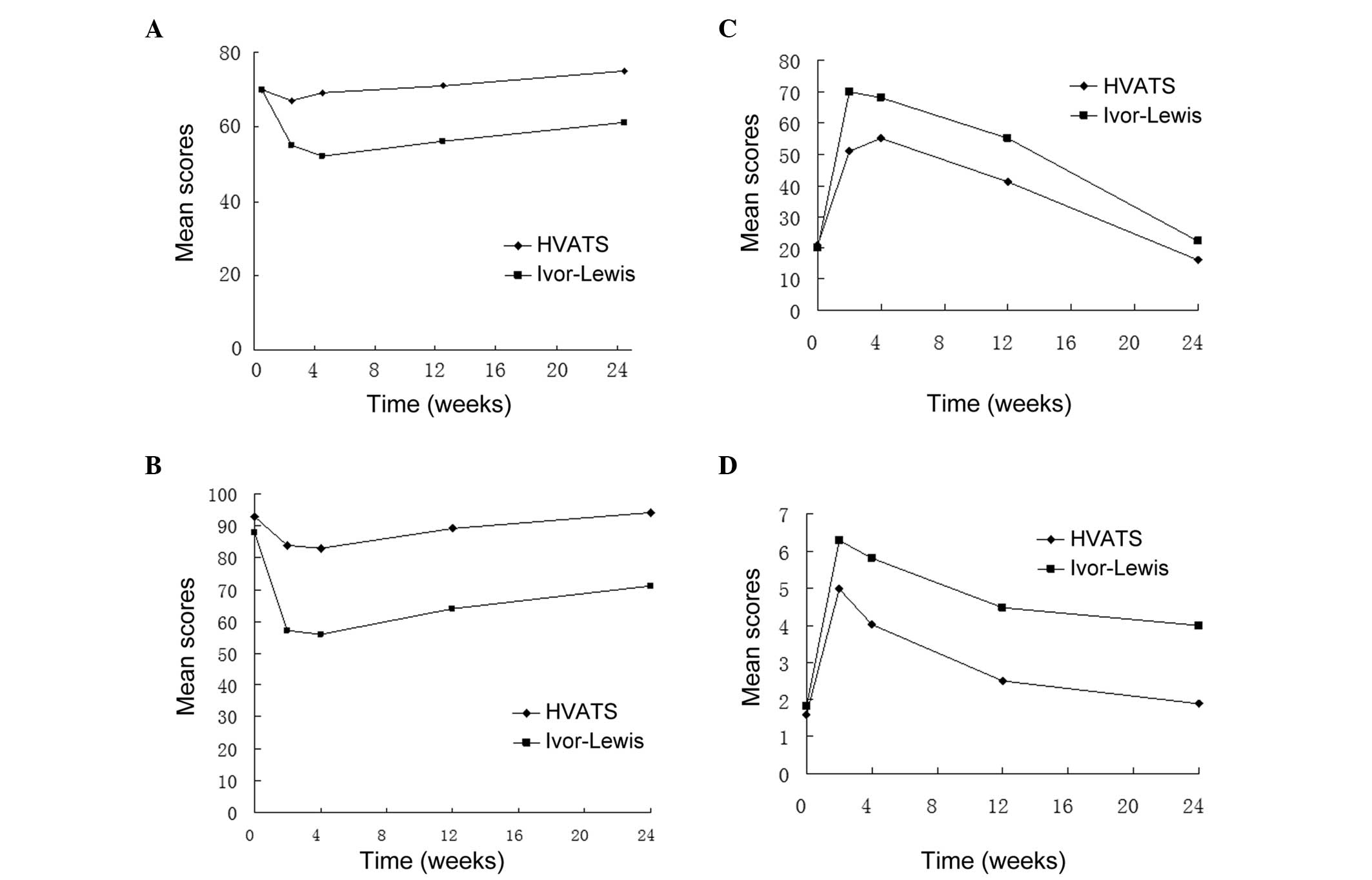Assessment of health‑related quality of life of patients with esophageal squamous cell carcinoma following esophagectomy using EORTC quality of life questionnaires
- Authors:
- Hongchang Shen
- Jue Wang
- Wenhuan Li
- Weiwei Yi
- Weibo Wang
View Affiliations
Affiliations: Department of Chemotherapy, Shandong Provincial Hospital Affiliated to Shandong University, Jinan, Shandong 250021, P.R. China, Department of Breast and Thyroid Surgery, Shandong Provincial Hospital Affiliated to Shandong University, Jinan, Shandong 250021, P.R. China
- Published online on: October 1, 2014 https://doi.org/10.3892/mco.2014.434
-
Pages:
133-138
Metrics: Total
Views: 0 (Spandidos Publications: | PMC Statistics: )
Metrics: Total PDF Downloads: 0 (Spandidos Publications: | PMC Statistics: )
This article is mentioned in:
Abstract
Esophageal cancer is one of the leading causes of cancer‑related mortality and surgery is currently the main treatment modality for resectable esophageal cancer. To assess health‑related quality of life (HRQL) of patients with esophageal squamous cell carcinoma (ESCC) following esophagectomy, 62 consecutive patients with middle ESCC were randomly assigned into hand video‑assisted thoracoscopic surgery (HVATS) (n=33) and Ivor‑Lewis surgery (ILS) (n=29) groups. Quality of life questionnaires (QLQ)‑C30 and QLQ‑OES18, published by the European Organization for Research and Treatment of Cancer, were used prior to treatment and at regular intervals until 6 months following surgery. The results of QLQ‑C30 and QLQ‑OES18 demonstrated that i) patients with comorbidities and advanced tumor stage (III‑IV) exhibited increased risk of poor HRQL, while their gender, age, body mass index and anastomosis location were not associated with HRQL at 6 months after surgery; ii) all the patients had worse functional, symptom and global scores within 6 months after surgery; iii) patients in the HVATS group had similar baseline functional and symptom scores to those of patients in the ILS group; however, their functional and global scores were higher and their symptom scores were lower compared to those of patients in the ILS group; iv) the HRQL of patients in the HVATS group returned to preoperative levels within a shorter time period compared to patients in the ILS group. There were significant differences in global health, physical functioning, fatigue and pain scales between the two groups. In QLQ‑OES18, the dysphagia and gastroesophageal reflux scales were improved in both the HVATS and ILS groups, but no significant differences were observed between the two groups. In addition, the overall survival rate was similar in the two groups. Taken together, our findings indicated that HVATS is a safe procedure, associated with less disturbance to short‑term HRQL compared to ILS. Therefore, it appears reasonable to select HVATS for patients with early‑stage middle esophageal cancer.
View References
|
1
|
Jemal A, Siegel R, Ward E, Hao Y, Xu J,
Murray T and Thun MJ: Cancer statistics, 2008. CA Cancer J Clin.
58:71–96. 2008. View Article : Google Scholar
|
|
2
|
Gallo A and Cha C: Updates on esophageal
and gastric cancers. World J Gastroenterol. 12:3237–3242.
2006.PubMed/NCBI
|
|
3
|
Enzinger PC and Mayer RJ: Esophageal
cancer. N Engl J Med. 349:2241–2252. 2003. View Article : Google Scholar : PubMed/NCBI
|
|
4
|
Fabian T, Martin JT, McKelvey AA and
Federico JA: Minimally invasive esophagectomy: a teaching
hospital's first year experience. Dis Esophagus. 21:220–225.
2008.
|
|
5
|
Shichinohe T, Hirano S and Kondo S:
Video-assisted esophagectomy for esophageal cancer. Surg Today.
38:206–213. 2008. View Article : Google Scholar
|
|
6
|
Sunpaweravong S, Chewatanakornkul S and
Ruangsin S: Initial experience and result of thoracoscopic and
laparoscopic esophagectomy. J Med Assoc Thai. 91:1202–1205.
2008.PubMed/NCBI
|
|
7
|
Toker A, Eroglu O, Ziyade S, Tanju S,
Senturk M, Dilege S and Kalayci G: Comparison of early
postoperative results of thymectomy: partial sternotomy vs.
videothoracoscopy. Thorac Cardiovasc Surg. 53:110–113. 2005.
View Article : Google Scholar : PubMed/NCBI
|
|
8
|
Du JJ, Meng L, Chen JH, Peng ZM, Wang L,
Zhang L and Wang XH: Hand-assisted video-thoracoscopy for resecion
of esophageal cancer. Chin J Surg. 43:351–353. 2005.(In
Chinese).
|
|
9
|
Du JJ, Meng L, Chen JH, Peng ZM, Wang L,
Zhang L and Wang XH: Clinical therapeutic effect of esophageal
carcinoma with hand video assisted surgery. Chin J Surg.
45:822–824. 2007.(In Chinese).
|
|
10
|
Hjermstad MJI, Fossa SD, Bjordal K and
Kaasa S: Test/retest study of the European Organization for
Research and Treatment of Cancer Core Quality-of-Life
Questionnaire. J Clin Oncol. 13:1249–1254. 1995.PubMed/NCBI
|
|
11
|
Blazeby JM, Williams MH, Brookes ST, et
al: Quality of life measurement in patients with oesophageal
cancer. Gut. 37:505–508. 1995. View Article : Google Scholar : PubMed/NCBI
|
|
12
|
Nakata M, Saeki H, Yokoyama N, et al:
Pulmonary function after lobectomy: video-assisted thoracic surgery
versus thoracotomy. Ann Torac Surg. 70:938–941. 2000. View Article : Google Scholar : PubMed/NCBI
|
|
13
|
Walker WS, Codispoti M, Soon SY, et al:
Long-term outcomes following VATS lobectomy for non-small cell
bronchogenic carcinoma. Eur J Cardiothorac Surg. 23:397–402. 2003.
View Article : Google Scholar : PubMed/NCBI
|
|
14
|
Paiva JM and Wright GM: Hand-assisted
thoracoscopic surgery causes less postoperative pain than limited
thoracotomy after cessation of epidural analgesia. Heart Lung Circ.
13:374–378. 2004. View Article : Google Scholar
|











